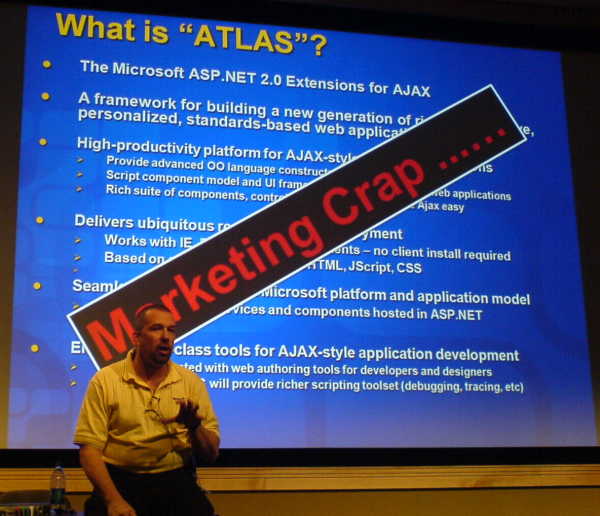
Joe Stagner is a kick boxer. He owns a gym. He is scared of Detroit. How did this come up? He was pushed to tell a tale of a trip to motown.
He claims that the Ajax landscape is currently more “widget toolbox”-y than a real stack. He is looking at Atlas to allow you to build Ajax apps that “you couldn’t” build with other platforms.
Case Study: Dominos Pizza
Timely delivery is fundamental to the profit/loss: “If the pizza isn’t at your doorstep in 30 mins it is free”.
What if the caller id caught the info, converted the number to an address via white pages, used a geo locator to get the long/lat, and then got a picture of the front door so the driver knows the door.
The long/lats will be queued up and when the driver leaves it calculates the best route for the driver.
Joe enjoyed making fun of the genius of the marketing department took Atlas and made it:
- Microsoft ASP.NET 2.0 Ajax Extensions 1.0: the server side stuff
- Microsoft AJAX Client Library: the client side stuff
- ASP.NET AJAX Control Toolkit
- ASP.NET AJAX Futures CTP
- Codeplex.com Additions
When asked why Microsoft did their own thing on the client side (instead of focusing on the server side piece and integrating with Dojo or …):
Why create your own client side library instead of working with one of the other libraries. Joe felt that the language extensions were necessary for commercial development on Ajax. The customers want the synergy of the client and the server side.
I think that it is all about control ;)
Joe booted up Visual Web Developer 2005 and showed Ajax Tutorial 101 for Atlas… creating a button that updates a panel. After doing a quick demo, he showed a bunch of tools from the toolbox side of things such as a ConfirmButtonExtender.
One of the examples was gym software, and when Ben asked if this was software that Joe uses to manage his gym, Joe bound down from the stage. For a second I thought that he was going to judo chop Ben, but he whispered “I run my site on phpNuke” :)
Finally, Joe booted into Ubuntu 6.1 in Virtual PC and showed the stack running over there.


